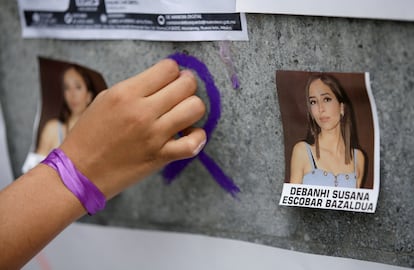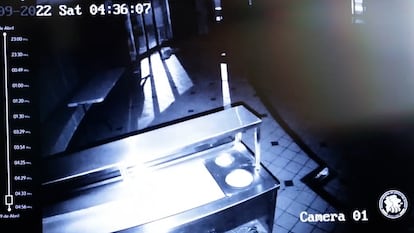The main unknowns in the ‘Debanhi Escobar case’: The death that’s shocked Mexico
A week after the discovery of the young woman’s body, the investigation remains at a standstill. Why was she running to the motel? Was she sexually abused? And how did she end up at the bottom of a cistern?

More than a week has passed since the body of Debanhi Escobar was found at the bottom of a cistern in the Mexican city of Monterrey, but Mexico’s authorities are still no closer to solving the mystery. The 18-year-old student went missing on April 9, and it took police 13 days to find her remains. The Prosecutor’s Office of the state of Nuevo León has come under mounting public scrutiny for its handling of the case, and has been forced to admit to committing serious mistakes in the investigation.
The Debanhi Escobar case has become a symbol of the tortuous path that the victims of disappearances and femicides must take to achieve justice in Mexico. Key witnesses, such as Escobar’s two friends and the driver who was the last person to see her alive, have tried to put the blame on Escobar, leading to headlines such as “She was drunk” and “She was out of her senses.” Another news report suggested the 18-year-old could have consumed drugs the night of her death. And one local outlet even created a poll about her death, asking readers: “Do you think that Debanhi Escobar’s death was due to... Homicide / Accident / Don’t know.” The media furor has not revealed anything useful about how the young woman died, but rather diverted attention from what’s really important: the questions the Prosecutor’s Office still has not answered.
What happened at Quinta El Diamante?
The night of her disappearance on April 8, Escobar went to a party with two women, Ivonne and Saraí – their surnames have not been disclosed. One of them was a friend of Escobar, the other just an acquaintance. After going to at least three places, the three end up at a venue called Quinta El Diamante. In a television interview for the Mexican channel Televisa Monterrey, the two women said they were at the venue with some boys they had met before at the entrance of another party, and three more young men that Escobar greeted upon arrival. They stayed at Quinta El Diamante until approximately 3.50am.
As they were leaving, “some people wanted to take Debanhi,” the friends said in the interview. These people said they wanted to take Escobar home, but the women didn’t trust them. At 4am, Ivonne and Saraí put Debanhi in a taxi owned by a man named David Cuéllar, who works for the ride-hailing app DiDi. He had been driving the women around that night and the women had his number. Ivonne and Saraí went home in another car because Escobar wanted to go home alone, they said. There is no more information, apart from what the friends have said, about what happened and who else could have approached Escobar that night.
Did the taxi driver assault her?
Security camera footage shows that Escobar got into the passenger seat of David Cuéllar’s car. Debanhi’s father, Mario Escobar, was the first to accuse Cuéllar of having tried to sexually assault his daughter. According to him, the 46-year-old tried to touch Escobar’s breasts and this was the reason why she got out of the car a few minutes later and was later spotted alone on the Monterrey-Nuevo Laredo highway.
But the driver has denied the alleged harassment. In a separate interview, he said that she got out of the car “of her own free will.” It was at this moment, that the driver took a photo in which Escobar is seen standing alone, in an ankle-length skirt and Converse shoes, in the middle of nowhere – an image that has come to symbolize the case. Authorities said that Cuéllar has cooperated in the investigation and have ruled out any crime.
What happened at the transportation company?
In the videos that the Prosecutor’s Office released on Wednesday, the young woman is seen walking along the road towards the first place she found that was open: a transportation company called Alcosa. Security camera footage from the office shows Escobar crossing the road and approaching a security booth at 4.29am. Although the Prosecutor’s Office initially said that Escobar entered the building, authorities now say there are no more records of her being at the company from that moment on.
Why was she running when she entered the motel?
Five minutes later and on the same sidewalk, a camera from the Nueva Castilla motel captures Debanhi running as she entered the premises. The time is 4.35am. The motel, which is a complex of several buildings, has a restaurant on the right side of the entrance. This restaurant, which has been closed for many years, opens onto a garden area with a swimming pool. The cistern is located nearby in this area. It is striking that the recording shows the young woman running alone through the entrance. Was she fleeing from something or someone? Was she trying to hide? The authorities have not answered this question.
The Prosecutor’s Office initially said that the motel did not keep records of its security camera footage, but last week three videos from the motel suddenly appeared. It is also strange that only the cameras at the abandoned restaurant recorded footage of Escobar. There is no trace of the young woman in the videos from the motel’s reception area, or any other part of the facility. The head of the Femicide Prosecutor’s Office, Griselda Núñez, told the Mexican newspaper Milenio that they have “located new cameras that could have a record [of Escobar].” But authorities have provided no further information.
Why did she go to the abandoned restaurant?
The same restaurant security camera shows Escobar approaching the abandoned restaurant at 4.36am. Authorities have not explained whether or not she went to the motel reception afterwards. The same camera shows the 18-year-old in the pool area at 4.56am. But the restaurant and the pool area, where the cistern is located, are separated by a wall. Authorities have not explained how she crossed into this part of the premises without going through the motel. Nor have they explained what she was doing at the abandoned restaurant or if she was at another place in the motel that could shed light on how she died.

How come her body wasn’t found in four searches?
Escobar’s body was found on April 21 in the motel’s cistern after the premises had been searched by authorities on at least four occasions. This is despite that the fact that the cistern was just a few meters from where the young woman had last been seen alive and the starting point for the 13-day long search operation. The Prosecutor’s Office has not responded to this question, except to say that they are investigating oversights made by officials and will hold all negligent parties responsible. Two prosecutors have already been dismissed.
Authorities have also not explained either why motel workers did not notice the smell of the corpse until more than a week after the death. Nor why there wasn’t a single witness that night, not even from the 24-hour security service, who saw the young woman or someone else.
Why did they lie about the motel security cameras?
One of the big unresolved questions is the role of the motel in the Debanhi Escobar case. Did the Nueva Castilla motel lie about its camera records or was it the Prosecutor’s Office? There is no information about the rest of the cameras or whether the records could have been deleted or edited in the time between the young woman’s death and the discovery of her body. No one has yet been charged with obstruction of justice.
How did Escobar get to the bottom of the cistern?
There are many controversial theories about how the 18-year-old ended up at the bottom of the cistern. The Prosecutor’s Office initially suggested that the young woman had fallen into the cistern by herself, without explaining if the tank was open – there are aerial images prior to her death that show a lid. This theory has triggered a wave of criticism, including from Escobar’s family. Shortly after, authorities said that the cause of death was a “deep contusion to the skull.”
What they have not specified is whether this blow occurred before or after Escobar fell or was thrown into the cistern. Authorities also have not explained whether the contusion was caused by an aggressor or if it was the result of a fall. There is hardly any autopsy data and they have not said whether or not there was evidence that Escobar was sexually abused, which would lead the investigation directly to femicide.
A forensic doctor with decades of experience told EL PAÍS that sexual abuse injuries can still be detected in a body, even if it has been submerged for more than 10 days. According to the doctor, it is impossible for tissue to regenerate after death, meaning it can be analyzed.
Tu suscripción se está usando en otro dispositivo
¿Quieres añadir otro usuario a tu suscripción?
Si continúas leyendo en este dispositivo, no se podrá leer en el otro.
FlechaTu suscripción se está usando en otro dispositivo y solo puedes acceder a EL PAÍS desde un dispositivo a la vez.
Si quieres compartir tu cuenta, cambia tu suscripción a la modalidad Premium, así podrás añadir otro usuario. Cada uno accederá con su propia cuenta de email, lo que os permitirá personalizar vuestra experiencia en EL PAÍS.
¿Tienes una suscripción de empresa? Accede aquí para contratar más cuentas.
En el caso de no saber quién está usando tu cuenta, te recomendamos cambiar tu contraseña aquí.
Si decides continuar compartiendo tu cuenta, este mensaje se mostrará en tu dispositivo y en el de la otra persona que está usando tu cuenta de forma indefinida, afectando a tu experiencia de lectura. Puedes consultar aquí los términos y condiciones de la suscripción digital.
More information
Últimas noticias
Most viewed
- Reinhard Genzel, Nobel laureate in physics: ‘One-minute videos will never give you the truth’
- Oona Chaplin: ‘I told James Cameron that I was living in a treehouse and starting a permaculture project with a friend’
- Pablo Escobar’s hippos: A serious environmental problem, 40 years on
- Why we lost the habit of sleeping in two segments and how that changed our sense of time
- Charles Dubouloz, mountaineering star, retires at 36 with a farewell tour inspired by Walter Bonatti









































